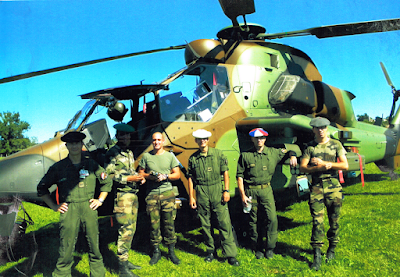The French Army Light Aviation (Aviation légère de l’armée de Terre, ALAT) is the Army aviation service of the French Army. ALAT was established on 22 November 1954 for observation, reconnaissance, assault and supply duties.
In 1912, the French military aviation was formally
incorporated into the French Army, alongside the four longstanding divisions of
infantry, cavalry, artillery, and engineers. As such it played important role
in WWI in support of the army: observation, artillery guidance, bombing and
strafing. In 1934, the aviation division turned into the French Air Force.
After WWII, it was felt that, just like the navy, the army
needed its own air branch, distinct from the air force, which led to ALAT's
creation in 1954.
Since it has participated in almost all French military
engagements and humanitarian aid deployments: the French Indochina War, the
Algerian War, the Persian Gulf War of 1990–91, the Lebanese conflict, the war
in Chad, the independence of Djibouti, the War in Somalia, operations in
Bosnia-Herzegovina, the Kosovo War, the Indonesian occupation of East Timor,
the Opération Licorne in Côte d'Ivoire, the humanitarian response to the
December 2004 Indian Ocean earthquake and tsunami, the War in Afghanistan, 2011
military intervention in Libya.

The blue berets were distributed for the first time in July
1954 to the helicopter units of the Army in Indochina (GFHATI). In order to
strengthen the cohesion of the GFHATI, Commander CRESPIN wanted to unify the
headgear in service, by adopting a beret in "RAF blue" color. Faced
with a lack of resources and the slowness of the administration, he had managed
to recover, from the quartermaster's office, a stock of blue berets abandoned
by the metropolitan paratroopers (NB: the latter nevertheless wore it until
1957).
It is worn tilted on the left side and does not have a rank
insignia.
Before the adoption of the ALAT-specific beret badge in
1957, personnel from certain units that already had a corps badge wore it on
their beret.
 |
| Pakol worn by ALAT members of ISAF, Afghanistan |
Since 2018, the 4th Special Forces Helicopter Regiment
(RHFS) has a new beret. The special forces regiment maintains a strong link
with the ALAT, but is now subordinate to the pillar of the Land Special Forces
Command.
It reflects the regiment's attachment to the ALAT by keeping
the cobalt blue colour of the original beret and projects itself into the new
FS pillar by displaying the embroidered CFST insignia, like the former SAS.
The embroidered badge is composed of the wings of the
paratroopers on either side of the commandos' dagger, surmounted by the
intelligence star.























%20.png)





























